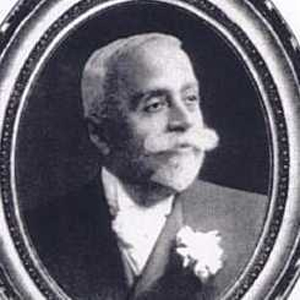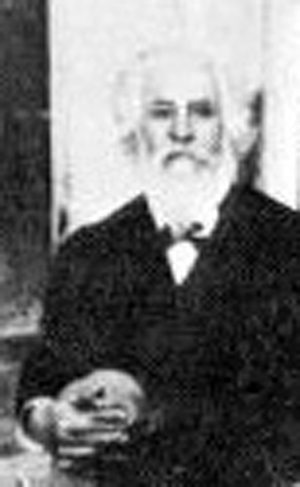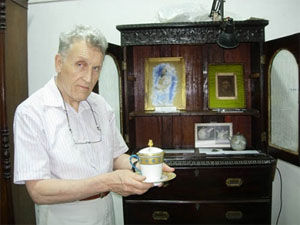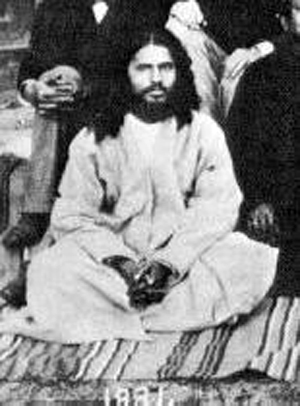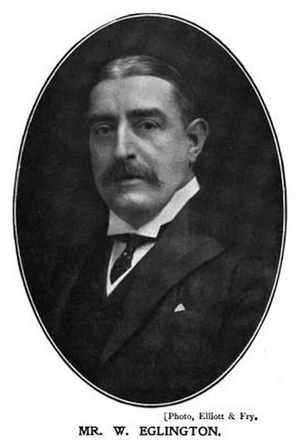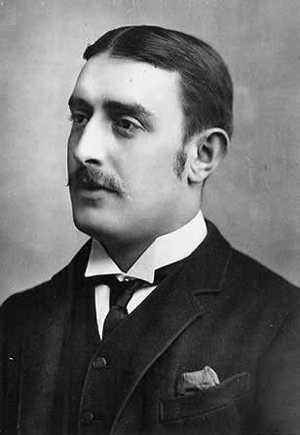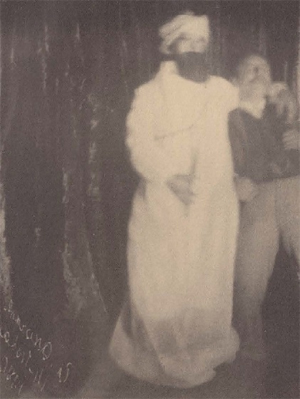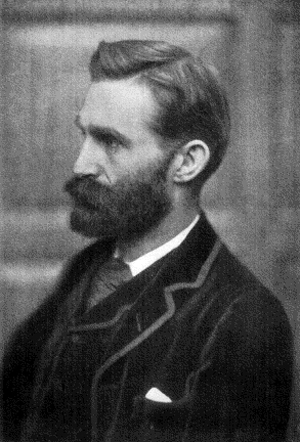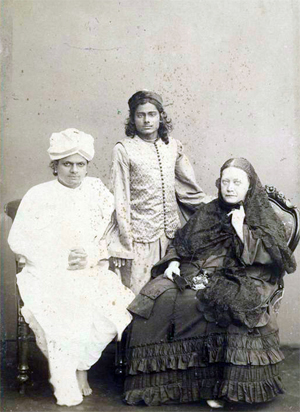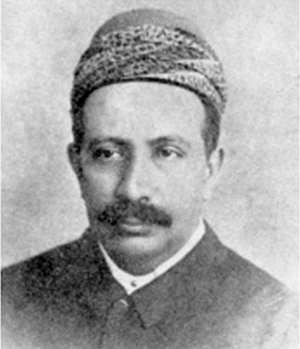by Wikipedia
Accessed: 9/4/20
The Name's Slick, Tom Slick
There's very little doubt that Tom Slick did some work for the CIA. He certainly would have been the right person to have on board for such an ingenious project -- namely, to do a bit of localized spying under a carefully scripted ruse of looking for a bunch of Yetis. Not only did Slick have a genuine fascination for cryptozoology in general and the Abominable Snowman in particular, but he moved in a lot of powerful circles with numerous Significant people -- many of whom were linked to the secret worlds of spying, the CIA, official chicanery, and Intelligence gathering. One of those, and a good friend to Slick, was Sir Ellice Sassoon, 3rd Baronet, GBE, a resident of Shanghai who spent a great deal of time protecting and advancing Western interests in the Far East and the Orient.
-- Chapter 9: A Yeti-Hunting 007, from "True Stories of Real-Life Monsters" [Excerpt], by Nick Redfern
The following is an extract from a letter purporting to be written by Madame Blavatsky from Poona to Madame Coulomb at Madras in October, 1883:—Now, dear, let us change the programme. Whether something succeeds or not I must try. Jacob Sassoon, the happy proprietor of a crore of rupees, with whose family I dined last night, is anxious to become a Theosophist. He is ready to give 10,000 rupees to buy and repair the headquarters; he said to Colonel (Kzekiel, his cousin, arranged all this) if only he saw a little phenomenon, got the assurance that the Mahatmas could hear what was said, or give him some other sign of their existence (?!!) Well, this letter will reach you the 26th, Friday; will you go up to the Shrine and ask K. H. (or Christofolo) to send me a telegram that would reach me about 4 or 5 in the afternoon, same day, worded thus: —"Your conversation with Mr. Jacob Sassoon reached Master just now. Were the latter even to satisfy him, still the doubter would hardly find the moral courage to connect himself with the Society.
"Ramalinga Deb."
If this reaches me on the 26th, even in the evening, it will still produce a tremendous impression. Address, care of N. Khandallavalla, Judge, Poona. Je ferai le reste. Cela coutera quatre ou cinq roupies. Cela ne fait rien.
[Google translate: I will do the rest. It will cost four or five rupees. This do nothing.]
Yours truly,
(Signed) H. P. B.
The envelope which Madame Coulomb shows as belonging to this letter bears the postmarks Poona, October 24th; Madras, October 26th; 2nd delivery, Adyar, October 26th; (as to which Madame Blavatsky has written in the margin of my copy of Madame Coulomb's pamphlet: [1] ["Some Account of my Intercourse with Madame Blavatsky," &c.] "Cannot the cover have contained another letter? Funny evidence!") Madame Coulomb also shows in connection with this letter an official receipt for a telegram sent in the name of Ramalinga Deb from the St. Thome office, at Madras, to Madame Blavatsky, at Poona, on October 26th, which contained the same number of words as above...
I will begin with number 1, relating to the Sassoon telegram. The matter is rather complicated, and the details of my investigation are given in Appendix: I. Here I will briefly state the results. Firstly, it became clear to me from conversations with Messrs. A D. and M. D. Ezekiel, who spent much time with Madame Blavatsky during her visit at Poona in October, 1883, and from the written statement of Mr. N. D. Khandalvala, in whose house she stayed, that the actual circumstances during her stay there were quite consistent with the letter. Secondly, I have been unable to obtain any trustworthy evidence for the existence of such a person as Ramalinga Deb, who was represented by Madame Blavatsky as a Chela, residing in Madras, of the Mahatma with whom she professed to be in occult communication. Thirdly, a careful comparison of Madame Blavatsky's attempt to disprove the genuineness of this letter (see Appendix I.) with the statements of Messrs. Ezekiel and Khandalvala appears to me to strengthen the case against her; for it leads us to the conclusion that she must have made a specific pre-arrangement for a conversation, the whole point of which was that its subject should have arisen extempore...
APPENDIX 1: THE SASSOON TELEGRAM (vide p. 217), &c.
Some of the details which follow, and which serve to explain the extract quoted on p. 211, I have learnt from the oral statements of Messrs. A. D. and M. D. Ezekiel, and the written statements of Mr. Khandalvala shown to me by Dr. Hartmann.
Madame Blavatsky, on her way from Bombay to Madras, in October, 1883, stayed at Poona several days at the house of Mr. N. D. Khandalvala, a member of the Theosophical Society. On October 23rd she dined at the house of Mr. Jacob Sassoon, who was desirous of seeing some ''phenomenon.'' Madame Blavatsky despatched the letter from which the extract is taken, to Madame Coulomb on the morning of the 24th. While driving with Mr. A. D. Ezekiel on the afternoon of the 24th, she expressed her desire to call upon Mr. Sassoon. Probably she intended, when she wrote to Madame Coulomb, to arrange for a conversation with Mr. Sassoon on the afternoon of the 26th, when the subject of the telegram would be mentioned — only, of course, after much entreaty by Mr. Sassoon for some phenomenon; but, finding that Mr. Sassoon purposed leaving Poona on the 25th, she was compelled, if she was to impress him at all, to take the needful action earlier than she had anticipated. On this afternoon, then, of the 24th, after refusing to show Mr. Sassoon any phenomena, she professed, by some "occult" mental process, to get the opinion of Ramalinga's Master; but, having imperfectly heard his answer, she wished mentally, as she said, that Ramalinga should communicate to her the words in writing, that she might satisfy herself that she had heard aright. She wrote down at the time the words she expected to receive, and said that Ramalinga would send a telegram to her at once, or that she might not receive it till after a day or two. The telegram did not arrive till the 26th. Madame Blavatsky's explanation of the delay is that Ramalinga sent on the words late to Mr. Babajee D. Nath, who copied them and gave them to Madame Coulomb to be sent by telegram. This explanation was given to me by Madame Blavatsky, and appears also in the letter professedly written by her on October 26th to Colonel Olcott. Madame Blavatsky was too shrewd openly to lay stress upon the telegram, but I have no doubt, after conversations with Messrs. A. D. and M. D. Ezekiel, who were present at Mr. Sassoon's on the 24th, and at Madame Blavatsky's receipt of the telegram on the 26th, that she wished the occurrence to be regarded as " phenomenal," notwithstanding Mr. A. D, Ezekiel's statement to the contrary in his letter to the Times of India.
It may be pointed out in passing that Mr. Babajee D. Nath lends his sanction to Madame Blavatsky's explanation, and thus, the Blavatsky-Coulomb letters being genuine, implicates himself in the fraud.
The statement made by Madame Blavatsky when the September number of the Christian College Magazine appeared in Europe is as follows: —The third letter, supposed to be written from Poona, is an entire fabrication. I remember the letter I wrote to her from Poona. It asked her to send me immediately the telegram contained in a note from Ramalinga if he brought or sent her one. I wrote to Colonel Olcott about the experiment. He thinks he can find my letter at Madras. I hope to either get back Ramalinga's note to me or obtain a statement of the whole matter from him. How could 1 make a mistake in writing, however hurriedly, about the name of one of my best friends? The forgers make me address him — ''care of H. Khandalawalla'' — when there is no such man. The real name is N. D. Khandalawalla.
Now, in the first place, the H originally printed in the Christian College Magazine was a misprint or a miscopy for the N in the original document.
As for the letter supposed to have been written to Colonel Olcott, it proves nothing, even were it written at the time it professes to have been written, viz., October 26th, 1883. Colonel Olcott alleges that he found this letter among his papers at Madras on his return thither at the end of last year, though he was unable to tell me how, when, or where he had originally received it. I was afterwards informed by Mr. Damodar that Madame Blavatsky had sent it through him to Colonel Olcott, whom he was accompanying on his tour in 1883. My opinion is that this letter, which was shown to me, is ex post facto, and was not written earlier than towards the end of last year. There are two statements in the letter which appear to me to point to its having been written at the later date. One of these is Madame Blavatsky's expression of her deep distrust of the Coulombs; the other is the following: — Madame Blavatsky, after writing that Ramalinga objected to give the words to Madame Coulomb, and gave them to Babajee, who gave them to Madame Coulomb to be sent as a telegram, continues: " I received the telegram to-day, but as it said, 'Master has just heard your conversation' — when it was not 'just now' but yesterday that the conversation took place — it was a glorious failure!" Now the letter is dated October 26th, therefore "yesterday" would be October 25th. But the conversation took place on October 24th. If the letter was written a year after the events, the mistake is intelligible enough. It was probably concocted after the appearance of the Christian College Magazine in Europe, and then — if we are to regard Colonel Olcott as a dupe in the matter — sent to Mr. Damodar for insertion among Colonel Olcott's papers.
I have also seen the letter alleged to have been written by Ramalinga at the time, and it appeared to me to be written, in part at least, in the disguised hand of Madame Blavatsky. It is curious, too, that in this letter Ramalinga is represented as expressing a great dread of Madame Coulomb; and I may say here that my inquiries have not enabled me to discover that Mr. Ramalinga Deb's existence has ever been other than imaginary.
But a more serious flaw in the attempted explanation by Madame Blavatsky yet remains. Messrs. Khandalvala and Ezekiel maintain that Madame Blavatsky could not have written to Madame Coulomb on the 24th after the conversation took place at Mr. Sassoon's in time for her letter to reach Madame Coulomb on the 26th. She declares in her statement that she asked Madame Coulomb to send her "immediately the telegram contained in a note from Ramalinga if he brought or sent her one," and from her supposed letter to Colonel Olcott it appears that this expected telegram related to the Sassoon conversation. Hence this alleged request must have been made before the aforesaid conversation occurred; and it is apparently not denied by Madame Blavatsky that she did write to Madame Coulomb on the morning of the 24th. On Madame Blavatsky's own showing, therefore — if Messrs. Ezekiel and Khandalvala are right concerning the time of the conversation and the subsequent events which prevented her afterwards writing a letter — a specific pre-arrangement must have been made by her for a conversation, the whole point of which was that its subject should have arisen extempore.
---------
I may here notice some of Madame Blavatsky's allegations concerning other extracts which I have quoted. These allegations, among others, were published in a pamphlet issued in 1884, by the Council of the London Lodge of the Theosophical Society. Against extract (6), p. 213, she said: "There is no 'Maharajah of Lahore,' hence 1 could not have spoken of such a person, nor have been attempting mock phenomena for his deception." I do not suppose that any one who is familiar with Madame Blavatsky would maintain that she could not have written Us Maharajah de Lahore ou de Benares simply because there was no Maharajah of Lahore but only of Benares.
Concerning extract (7), p. 213, Madame Blavatsky said: ''All depends upon knowing who is 'Christopholo ' — a little ridiculous figure in rags, about three inches high; she wrote to say it had accidentally been destroyed. She joked over it, and I too." In reference to another extract (14) — where ''Christofolo" occurred, she said: '' 'Christopholo' was a name by which she [Madame Coulomb] called an absurd little figure, or image of hers. She gave nicknames to everything." And in B, Replies she wrote a propos of extract (7) (which occurs at the end of a letter about her intended movements for the next few months, and other practical matters), ''I deny having written any such thing on that same letter. I remember her telling me in a letter her magic Christopholo had melted in the sun, and I may have answered her something to that effect. But that after the serious letter that precedes I should write such bosh is impossible, not in my style at all."
Concerning extract (13), p. 215, she wrote: ''I could never, in writing to her who saw the man every day, use all his names and titles. I should simply have said, 'Dewan Bahadur,' without adding 'Rajanath Bao, the President of the Society,' as if introducing to her one she did not know. The whole name is evidently put in now to make it clear who is meant." Now I think it is probably true that Madame Blavatsky would not usually write the full name and titles of Mr. Ragoonath Rao, and I account for her having written them in the present case by supposing that she had just written them in the K. H. hand on the envelope of the Mahatma document she had prepared, and that they were consequently running in her mind.
-- The Hodgson Report: Report on Phenomena Connected With Theosophy, by Richard Hodgson and the Society for Psychical Research
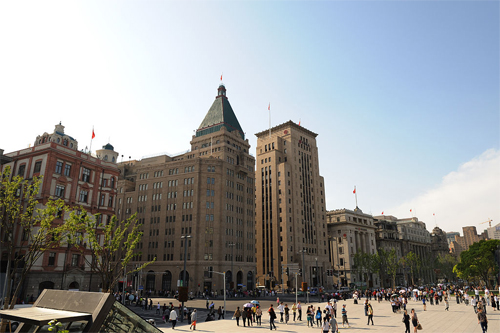
Sassoon House, Shanghai, China
The Sassoon family, known as "Rothschilds of the East" due to the immense wealth they accumulated in finance and trade,[1] is of Baghdadi Jewish descent and international renown. It was based in Baghdad, Iraq, before moving to Bombay, India, and then spreading to China, England, and other countries. It is said that the family descended from one of the court families of the Iberian Peninsula in the twelfth century.[2]. They later served as Financial Advisors to Islamic Rulers.
From the 18th century, the Sassoons were one of the wealthiest families in the world, with a corporate empire spanning the entire continent of Asia.[3]
Etymology
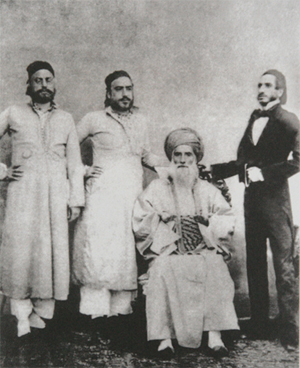
David Sassoon (seated) and his sons Elias David, Albert (Abdallah) & Sassoon David
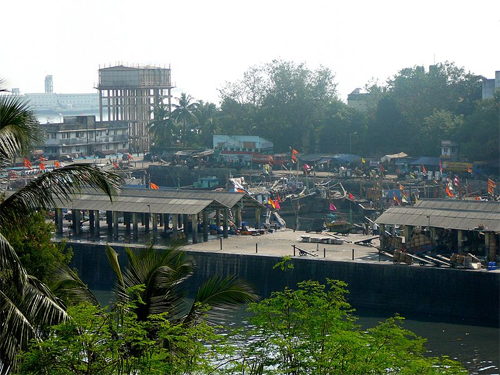
The Sassoon Docks, Mumbai, India
The name of the family strongly implies a local, Mesopotamian origin for the family. The family name of Sassoon is also commonly shared by many Armenian and Kurdish families and tribes who all originate from the mountainous district of Sason (whence the family and tribal names), west of Lake Van, in upper Mesopotamia in modern Turkey. It is, however, possible that some Spanish Sephardi blood was mixed with the primarily Mesopotamian Jewish Sasoons.
Origins
It is said the family descended from Joseph ben Solomon Ibn Shoshan, one of court official of the Iberian Peninsula in the twelfth century.
Sassoon ben Salih (1750–1830) and his family were the chief treasurers to the pashas of Baghdad and Southern Iraq. His sons David (1792–1864), and Joseph (1795–1872) fled from a new and unfriendly wāli, in 1828 David first went to the Persian Gulf port of Bushehr and in 1832 to Bombay, India, with his large family. In Bombay, he built the international business called David S. Sassoon, with the policy of staffing it with people brought from Baghdad. They filled the functions of the various branches of his business in India, Burma, Malaya, and east Asia. He cemented the family's dominant position in the Sino-Indian opium trade. (See First Opium War.) The family's businesses in China, and Hong Kong especially, were built to capitalise on the opium business.[1] His business extended to China – where Sassoon House (now the north wing of the Peace Hotel) on the Bund in Shanghai became a noted landmark – and then to England. In each branch, he maintained a rabbi. His wealth and munificence were proverbial; his philanthropy across Asia included the building of schools, orphanages, hospitals, and museums with the proceeds of the drug trade. On his death, tributes to him were made from across the continent by Muslims, Christians, Parsees, Jews, and Hindus.[3]
Joseph Sassoon sons
Joseph Sassoon went to Aleppo, Syria, where he established a merchant house and later his business interests spread to Alexandria, Thessaloniki, and Athens, which included a shipping company and a money exchange house. His five sons branched out in many directions: his son Moses Sassoon (1828–1909) returned to Baghdad before moving to Egypt where he built the financial house Joseph Sassoon & Sons, which later expanded and became an agent for Crédit Foncier in Egypt. In 1871 Moses' son Jacob Sassoon (1850–1936) was one of the largest cotton plantation owners in Egypt, and owned cotton mills; during the American civil war his older brother Nissim (1840–1917) had made a fortune exporting Egyptian cotton to England making him Egypt's largest cotton exporter. In 1927, with Misr Bank and other Egyptian businessmen, Jacob Sassoon founded of Misr Spinning and Weaving Company (Arabic: شركة مصر للغزل والنسيج), also known as Misr Helwan or the El-Ghazl factory owning 61% of the company's shares. Jacob Sassoon also founded Egypt Crédit Foncier with the Joseph Vita Mosseri, his grandson Eliau Joseph Sassoon was an architect, and designed the Asicurazione de Trieste Building. Eliau Sassoon was also a real estate investor and developer, who foresaw the unparalleled growth of Cairo and the lucrative effect such expansion would have on land values. It is not surprising, therefore, that many of the properties he invested in were located at the nexus of the elegant European quarter of Ismailia or in the choicest parts of Kasr al-Dubara, and later, in Garden City, Zamalek, and Giza. In 1952 his grandson Eliau (Elias) Nissim Eliau Joseph Sassoon (1928–2010) founded Banque Du Caire with Maurice Joseph Cattaui (1925–2009).
Eliau (Elias) Nissim Joseph Sassoon
Eliau (Elias) Nissim Eliau Joseph Sassoon (Hebrew: אליהו נסים אליאו יוסף ששון) (1928-2010), (always called Elias), born in Aleppo, Syria, to Nassim Eliau Sassoon (1911–1988) a wealthy merchant, banker, and former partner at Safra Freres a bank based in Aleppo, and Messouda Sassoon (born Shamash) (1911–1992).
Elias Sassoon was Joseph Sassoon's most influential and wealthiest descendant, in 1940 he was sent to Alexandria to attend the prestigious boarding school, Victoria College. He later joined his family's business in 1946 where he worked for the family's business in Egypt.
Among the many holdings, the family had at the time included interests in the Burmah Oil Company, Turkish Petroleum Company and the Anglo-Iranian Oil Company, a textile factory, a large cotton export business and interests in both the General Company of Commerce and Industry of Greece (later Attica Enterprises Holding S.A.) and Atlas Maritime.
In 1947 Elias focused his attention on three primary sectors: the new booming oil exploration industry sweeping the Middle East, shipping and banking. With a £5000 loan from his father, Elias invested in Standard Oil adding to his family's existing holdings in the company. That same year he married Hannah Rochel Jacque Sassoon (née de Menasche) (1929–2009), granddaughter of Baron Jacques Bohor Yacoub Levi de Menashe (d.1916).
His great-grandfather, David Solomon Sassoon (1871–1956) had been an investor in Socony-Vacuum Oil Company, which later partnered with Standard Oil to provide markets for the oil reserves in the Middle East. In 1906, SOCONY (later Mobil) opened its first fuel terminals in Alexandria with financing provided by David Solomon Sassoon. Elias Sassoon was a devoted Zionist and considered the British anything but friends to the Jewish people because of their blockade in the Mediterranean to refugee vessels carrying Jewish refugees fleeing the horrors of World War II, and although to a lesser extent, he considered the British government as culpable nonetheless in the atrocities against world Jewry.
Two extracts from contemporary sources will introduce and suggest the theme to be expanded. The first extract is from Roosevelt's own files. The U.S. Ambassador in Germany, William Dodd, wrote FDR from Berlin on October 19, 1936 (three years after Hitler came to power), concerning American industrialists and their aid to the Nazis:Much as I believe in peace as our best policy, I cannot avoid the fears which Wilson emphasized more than once in conversations with me, August 15, 1915 and later: the breakdown of democracy in all Europe will be a disaster to the people. But what can you do? At the present moment more than a hundred American corporations have subsidiaries here or cooperative understandings. The DuPonts have three allies in Germany that are aiding in the armament business. Their chief ally is the I. G. Farben Company, a part of the Government which gives 200,000 marks a year to one propaganda organization operating on American opinion. Standard Oil Company (New York sub-company) sent $2,000,000 here in December 1933 and has made $500,000 a year helping Germans make Ersatz gas for war purposes; but Standard Oil cannot take any of its earnings out of the country except in goods. They do little of this, report their earnings at home, but do not explain the facts. The International Harvester Company president told me their business here rose 33% a year (arms manufacture, I believe), but they could take nothing out. Even our airplanes people have secret arrangement with Krupps. General Motor Company and Ford do enormous businesses[sic] here through their subsidiaries and take no profits out. I mention these facts because they complicate things and add to war dangers.8
Second, a quote from the diary of the same U.S. Ambassador in Germany. The reader should bear in mind that a representative of the cited Vacuum Oil Company — as well as representatives of other Nazi, supporting American firms — was appointed to the post-war Control Commission to de-Nazify the Nazis:January 25. Thursday. Our Commercial Attache brought Dr. Engelbrecht, chairman of the Vacuum Oil Company in Hamburg, to see me. Engelbrecht repeated what he had said a year ago: "The Standard Oil Company of New York, the parent company of the Vacuum, has spent 10,000,000 marks in Germany trying to find oil resources and building a great refinery near the Hamburg harbor." Engelbrecht is still boring wells and finding a good deal of crude oil in the Hanover region, but he had no hope of great deposits. He hopes Dr. Schacht will subsidize his company as he does some German companies that have found no crude oil. The Vacuum spends all its earnings here, employs 1,000 men and never sends any of its money home. I could give him no encouragement.9
And further:These men were hardly out of the building before the lawyer came in again to report his difficulties. I could not do anything. I asked him, however: Why did the Standard Oil Company of New York send $1,000,000 over here in December, 1933, to aid the Germans in making gasoline from soft coal for war emergencies? Why do the International Harvester people continue to manufacture in Germany when their company gets nothing out of the country and when it has failed to collect its war losses? He saw my point and agreed that it looked foolish and that it only means greater losses if another war breaks loose.10
The alliance between Nazi political power and American "Big Business" may well have looked foolish to Ambassador Dodd and the American attorney he questioned. In practice, of course, "Big Business" is anything but foolish when it comes to promoting its own self-interest. Investment in Nazi Germany (along with similar investments in the Soviet Union) was a reflection of higher policies, with much more than immediate profit at stake, even though profits could not be repatriated. To trace these "higher policies" one has to penetrate the financial control of multinational corporations, because those who control the flow of finance ultimately control the day-to-day policies.
-- Wall Street and the Rise of Hitler, by Antony C. Sutton
In 1952 he cofounded Banque Du Caire with his childhood friend Moise Joseph Maurice Cattaui (1925–2009). By then Elias Sassoon had expanded his family's business to France, Brazil, South Africa and the United States where the family exported cotton to and had maintained trading posts since the 1800s.
The Sassoons believed that Mesopotamia (now Syria and Iraq) contained substantial reservoirs of oil, the forerunner of the Iraq Petroleum Company (IPC) the Turkish Petroleum Company (TPC). David Solomon Sassoon was among the first to secure the interest of the Imperial German banks and companies, already involved in the building of the Berlin–Baghdad railway, which he played an active role in its financing. This German interest was followed by British interests when David Sassoon became an agent for the Rothschilds in Ottoman Empire. In 1911, in an attempt to bring together British and German interests competing in the region, Sassoon formed a consortium of British investors composed of banks and companies and formed the African and Eastern Concession Ltd.
In 1953 Elias Sassoon used these networks of interests to expand his family's investment interests to include mining concessions in Africa. In 1957 the new Egyptian post-revolution government under Nasser nationalized all European particularly British and French companies and banks. The government also began expelling foreigners and the Jewish community of Egypt once again, despite its many contributions to the country's artistic, economic, political, and academic fields found itself under the government's harassment and intimidation, many were forced to leave the country with no more than one suitcase and most had their assets and properties seized by the Revolutionary Council.
The Sassoons were among those, whose assets were confiscated and in 1966 Elias Sassoon and his wife were taken to the port in Alexandria and expelled from the country. Elias’ wife who was an Egyptian citizen was declared non-citizen, and at the request of the Egyptian government, Elias's Syrian citizenship was revoked. They were given laissez-passer (travel documents) and ordered aboard a ship bound for Greece, however, their son Edouard Elias Sassoon (1948–1985) who was a medical student at the University of Alexandria was denied exit visa.
The government accused Elias Sassoon of using his family's banking network to help smuggle assets belonging to members of the Jewish community out of the country and demanded that he return his assets held in Europe before his son is allowed to leave. After paying what amounted to ransom money, totaling £4 million and the intervention of both the French and the Greek governments, Edouard Sassoon joined his family in 1971, with his wife Josephine Celine Esther (née Cattaui) (1949–1994), daughter of Moise Cattaui who was also denied exit visa after her family was expelled from the country in 1964.
Elias Sassoon had established Sassoon Cattaui Investment Holding (later, Providence Group), a privately owned family hedge fund with Moise Cattaui in 1961 in Switzerland with assets from the Sassoon Family Trust, which had been formed in Lausanne, Switzerland in 1910. In 1970, the partners moved the company Curaçao (Netherlands Antilles) a private family investment group, which is not required to register with the SEC or comply with reporting requirements under the Dodd–Frank, reform act. It is said that at the time of formation of the Fund, the total value of assets under management in 1961 was £25million.
The Fund invested in commercial real estate properties in the U.S., Canada, and Greece as well as in precious metals, oil & gas, and securities. The Fund also speculated in the currency markets, among its many holdings are: BHP Billiton, the co-investor in Le Méridien Hotel company with Air France, American Express, GM, Wells Fargo Bank, HSBC, Lehman Brothers, Exxon Mobile, Conoco Phillips, Fendi, Giorgio Armani, Microsoft, Sun Microsystem, Midland Bank, stockbroking firm Frankel Pollak (which was later sold to Sasfin Bank, a Sassoon family bank based in South Africa) and S&P. It is rumored that at the time of Elias Sassoon's death, the Fund, which is not required to file its financials with the SEC had over $100 billion of assets under management, most of which are assets of both the Sassoon and Cattaui families.
David S. Sassoon sons
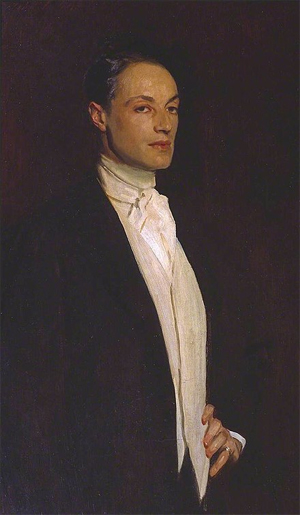
Sir Philip Sassoon, John Singer Sargent, 1923
Sassoon's eight sons also branched out in many directions. The Sassoon family was heavily involved in the shipping and opium production industry in China and India.
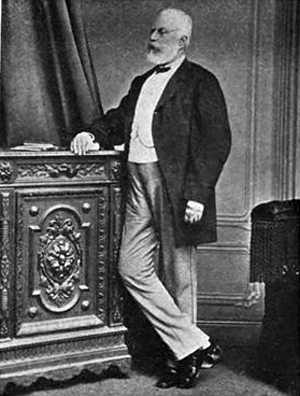
Elias David Sassoon
Elias David (1820–1880), his son by his first wife, had been the first of the sons to go to China, in 1844. He later returned to Bombay, before leaving the firm to establish E.D. Sassoon & Co. in 1867, with offices in Bombay and Shanghai.
Jacob Elias David Sassoon, 1st Baronet of Bombay
Birthdate: 1844
Birthplace: Hong Kong
Death: October 22, 1916 (71-72), Bombay | Mumbai, India
Immediate Family: Son of Elias David Sassoon and Leah Sassoon
Husband of Rachel Simon Isaacs
Partner of 施湘美 Mary Sheung Mei Zimmern
Father of 孫志昌 SUEN Chi-Cheung and Unknown Sassoon, Infant
Brother of Sir Edward Elias Sassoon, 2nd Baronet of Bombay; Hannah David; David "Nunkie" Sassoon; Meyer Harry Sassoon; Joseph Sassoon and 3 others
-- Jacob Elias David Sassoon, 1st Baronet of Bombay, by Geni.com
Another son, Albert Abdullah David Sassoon (1818–1896) took on the running of the firm on his father's death, and notably constructed the Sassoon Docks, the first wet dock built in western India. With two of his brothers he later became prominent in England, and the family were friends of the Prince of Wales, later King Edward VII. One daughter of the family, Rachel Sassoon Beer, joined her husband in running a number of British newspapers, including The Sunday Times (1893–1904) and The Observer, which she also edited.
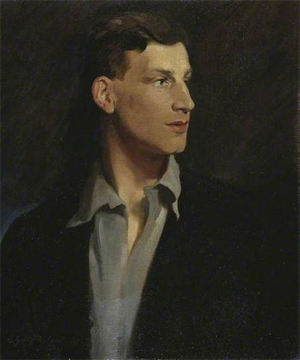
Portrait of Siegfried Sassoon by Glyn Warren Philpot, 1917. Fitzwilliam Museum
Of those who settled in England, Sir Edward Albert Sassoon (1856–1912), the son of Albert, married Aline Caroline de Rothschild, and was a Conservative member of Parliament from 1899 until his death. The seat was then inherited by his son Sir Philip Sassoon (1888–1939) from 1912 until his death. Philip served in the First World War as military secretary to Field Marshal Sir Douglas Haig and, during the 1920s and 1930s, as Britain's undersecretary of state for air. The twentieth-century English poet, one of the best known World War I poets, Siegfried Sassoon (1886–1967) was David's great-grandson.
Another descendant of David Sassoon is the British banker and former Treasury's commercial secretary James Meyer Sassoon. He was mentioned in the Paradise Papers as one of the beneficiaries of a tax exempt Cayman Island trust fund worth $236 million in 2007 and defended it as being of non UK origin.[4]
The branch which carried on the rabbinical tradition has been represented by Rabbi Solomon David Sassoon (1915–1985), who moved from Letchworth to London and then to Jerusalem in 1970. He was the son of one David Solomon Sassoon (1880–1942) who collected Jewish books and manuscripts and catalogued them in two volumes.
The bulk of this collection is stored at the British Library in London, England. Some examples of this collection are maintained at the University of Toronto Library in Toronto, Canada. None of these priceless works are presently stored in the United States.
David Sassoon was the son of Flora Abraham, who had moved from India to England in 1901 and established a famous salon in her London home. Solomon Sassoon had two sons, Isaac S. D. Sassoon and David Solomon Sassoon, who are both rabbis.
Family tree
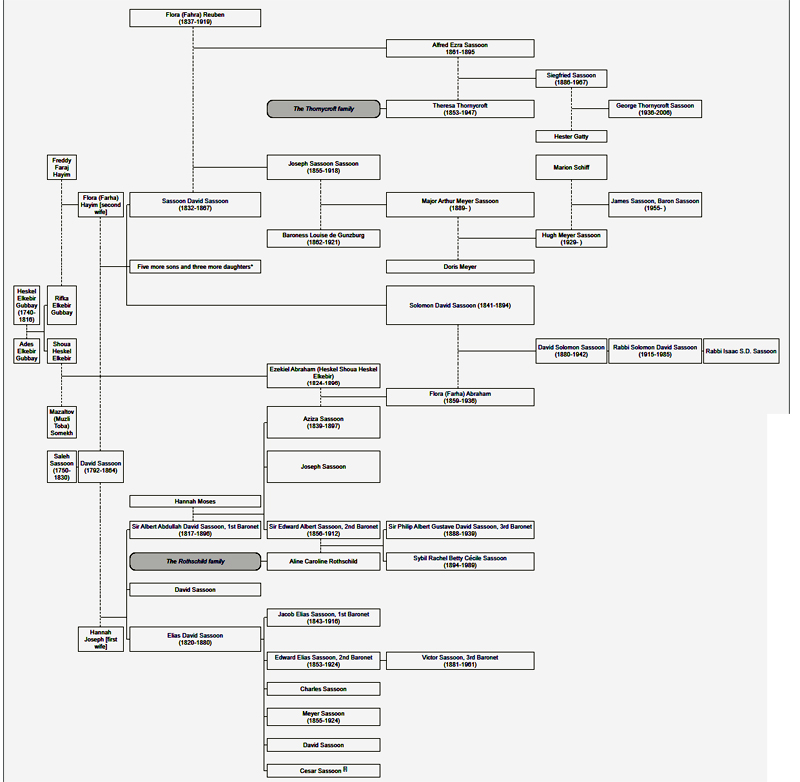
Sassoon family tree
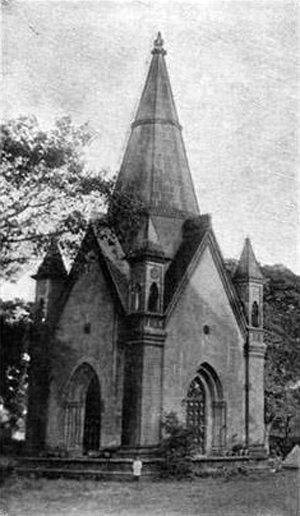
Tomb of David Sassoon, Pune, India
References
1. "SASSOON". Jewish Encyclopedia, 1906.
2. Jacobs, Schloessinger, Joseph, Max. "IBN SHOSHAN". http://www.jewishencyclopedia.com. Jewish Encyclopedia. Retrieved 30 September 2016.
3. Siegfried Sassoon: A biography, Max Egremont, (London 2005)
4. "James Meyer Sassoon". International Consortium of Investigative Journalists. 5 November 2017. Retrieved 5 November 2017.
External links
• Elkebir Family Tree, showing the ancestry of the Sassoon family back to the 18th century.
• Family Sassoon, About Sassoon family, Ozar Yisrael Encyclopedia, J. D. Eisenstein, Volume 10, p. 75
This article incorporates text from a publication now in the public domain: Singer, Isidore; et al., eds. (1901–1906). "Sassoon". The Jewish Encyclopedia. New York: Funk & Wagnalls.
*******************************
E.D. Sassoon & Co.
by Wikipedia
Accessed: 9/6/20

Elias David Sassoon
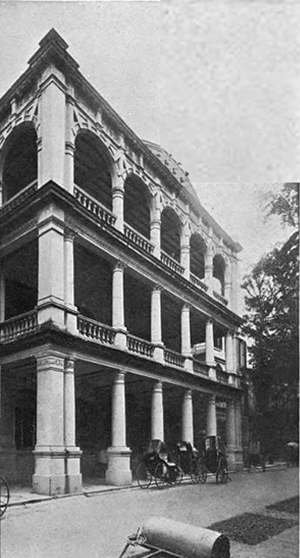
Offices of E.D. Sassoon & Co. in Bombay
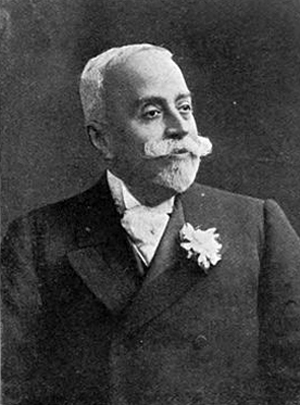
Jacob Sassoon
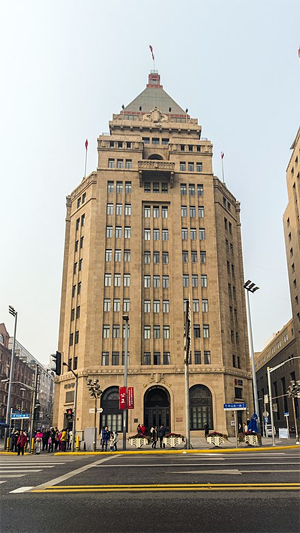
Former "Sassoon House", today "Peace Hotel″
E.D. Sassoon & Co., Ltd. was a trading company operating in the second half of the 19th century and the first half of the 20th century predominantly in India, China and Japan.
History
E.D. Sassoon & Co., Ltd. was founded in 1867 by Elias David Sassoon (1820–1880), the second son of David Sassoon (1792–1864), after he had broken away from his family's company, David Sassoon & Co., because of personal resentments between him and his brothers. The new company started to trade in dried fruits, nankeen, metals, tea, silk, spices and camphor from modest offices in Bombay and Shanghai.[1] But it soon focused on exporting opium, cotton and piece fabrics from India to China.[2]
E.D. Sassoon & Co. soon proved to be more energetic than David Sassoon & Co. and by the later Edwardian years its capital was two to three times as much (£1.25m to £1.5m) as the nominal capital of David Sassoon & Co. (£0.5m).[3] The company later expanded its operations to the Persian Gulf ports, Baghdad and Japan. From 1879[4] onwards it also bought up poorly performing cotton mills in Bombay and turned them into successful operations.
After the death of Elias David Sassoon in 1880, his eldest son Sir Jacob Elias Sassoon (1844–1916) took over the business and further branches were opened in Calcutta and Karachi. The firm also purchased property in Shanghai. But in 1907 the United Kingdom signed a treaty agreeing to gradually eliminate the opium exports to China over the next decade while China agreed to eliminate domestic production over that period. Following this treaty E.D. Sassoon & Co. retreated from the opium trade, eventually stopping it completely.[5] Instead the company invested further in its cotton mill business in Bombay. By the First World War E.D. Sassoon & Co. had grown into India’s single largest textile group and was renowned for their advanced production technology.
In 1909 Sir Jacob Elias Sassoon also played a very prominent role in forming the "Eastern Bank", taking advantage of the banks facilities to make themselves less vulnerable to fluctuations of the Indian rupee. On 1 January 1921, E.D. Sassoon & Co. Ltd was incorporated as a private trading and banking company, giving up its old partnership structure.[6]
After the death of Sir Edward Elias Sasoon (1853–1924) and his younger brother Meyer Harry Sassoon (1875–1924) within a year, Sir Edward Elias Sassoons son Sir Victor Sassoon (1881–1961) and Meyer Harry Sassoon's widow Mozelle Gubbay (1872–1964) became the main owners of the company with combined business assets of £15 million. Sir Victor Sassoon became the chairman of the company and Meyer Harry Sassoon's son-in-law, Derek Fitzgerald (1892–1967), was appointed manager of the London and Manchester branches.
In 1927, E.D. Sassoon & Co. Ltd was already the largest cotton mill owner in Bombay, where it was still headquartered. When the Great Depression in 1929-30 drove E.D. Sassoon's biggest competitors into bankruptcy, the company took them over. By the time the Second World War broke out in Europe, E.D. Sassoon & Co. owned 15 cotton mills and was with over 30,000 employees Bombays largest private employer.
The profits generated in Bombay were reinvested in luxury real estate and hotels in Shanghai. In 1923 E.D. Sassoon & Co. had bought the majority of shares of the established produce firm "Arnhold & Co."[7] of Shanghai, which in turn controlled the "Cathay Land Company". The latter owned several apartment buildings and a hotel in Shanghai and offered the perfect basis for further investments in Shanghai property.[8]
In 1928 Sir Victor Sassoon established the "E.D. Sassoon Banking Company Limited" as a subsidiary of "E.D. Sassoon & Co. Ltd", to coordinate the trading interests of his family.[9] In March 1930 E.D. Sassoon & Co. new headquarter was opened at "Sassoon House" in Shanghai.
The Second World War brought many changes to the E.D. Sassoon Group. Although the war boosted production rates, thanks to the soaring demand of the allied armies, the firm decided to dispose of the cotton mills in Bombay in 1943[10], fearing problems as foreign owners once independence to India was granted. In May 1949 Shanghai was under the control of a communist regime and seemed an unhealthy place for the company's head office, so this was transferred to Nassau in the Bahamas in 1950. It is thought that Nassau was chosen because there were no forms of personal or corporation tax in place and Sir Victor Sassoon planned to live there, which he did until his death in 1961.[11]
After Sir Victors Sassoon's death the banking subsidiary, E.D. Sassoon Banking & Co. Ltd., was sold in 1972 to the merchant bank "Wallace Brothers & Co. (Holdings) Ltd" and renamed "Wallace Brothers Sassoon Bank Ltd." in November 1974, which in turn was taken over by the Standard Chartered Bank in 1976.[12] The parent company, E.D. Sassoon & Co., continued to operate as a separate company from 1972 until 1978 when it became "DK Investments (Crosby Square) Ltd." (4 Crosby Square, City of London).
The "Sir Victor Sassoon Heart Foundation", set up by Lady Sassoon after her husband’s death, are run from Nassau, where the family still lives.
See also
• Companies portal
• David Sassoon
• Sassoon family
• David Sassoon & Co.
• List of trading companies
• History of opium in China
References
1. Stanley Jackson: ″The Sassoons - Portrait of a Dynasty″, Secon Edition, William Heinemann Ltd., London 1989, p.48 and 51, ISBN 0-434-37056-8
2. Madhavi Thampi: "India and China in the Colonial World", Social Science Press, London/ New York 2017, p.40; ISBN 978-1-138-10269-9
3. Stanley Chapman: "The Rise of Merchant Banking", Routledge, London/ New York 2006, p.131, ISBN 978-0-415-48948-5
4. In 1879 E.D. Sassoon & Co. moved from just trading in cotton into the cotton mill business by purchasing the bankrupt Alexandra Mills, which had been founded in 1869 by Jamsetji Nusserwanji Tata (1839-1904).
5. David Faure (Editor): "Society - A Documentary History of Hong Kong", Hong Kong University Press, Hong Kong 1997, p.125, ISBN 962-209-393-0
6. Stanley Jackson: ″The Sassoons - Portrait of a Dynasty″, Secon Edition, William Heinemann Ltd., London 1989, p.200, ISBN 0-434-37056-8
7. Arnhold & Co., based in Shanghai, had branches in Hankow, Tientsin, Canton and London. Apart from its controlling stake in the Cathay Land Company it was a leading distributor of building materials and engineering equipment. E.D. Sassoon & Co. sold its controlling interest in Arnhold in 1957.
8. Stanley Jackson: ″The Sassoons - Portrait of a Dynasty″, Secon Edition, William Heinemann Ltd., London 1989, p.212, ISBN 0-434-37056-8
9. "Archived copy". Archived from the original on 2015-04-02. Retrieved 2019-04-29.
10. E.D. Sassoon & Co.'s cotton mills were sold in 1943 to the Indian trading company "Messrs Aggarwal & Co.", which integrated them into their "The India United Mills Limited". These in turn were nationalized in 1974 by the Indian government. In the early 2000s they were wound down together with other textile mills in Bombay.
11. http://www.aim25.ac.uk/cgi-bin/vcdf/det ... &nv2=place
12. http://www.scribesoftheorient.com/blog/?p=33

